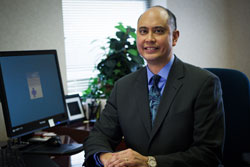Humanizing Health IT

By Ken Congdon
Follow Me On Twitter @KenOnHIT
In the almighty quest to secure Meaningful Use (MU) incentive dollars, it’s often easy for a healthcare provider to lose sight of the primary reason they are implementing all of these technology changes — the patient. This sentiment came through loud and clear during a recent interview I conducted with Richard Ong, CIO of St. Vincent Health System in Erie, PA (part of the Allegheny Health Network).
St. Vincent is no stranger to health IT adoption. This health system consisting of a 427-bed hospital and vast outpatient network was one of the first in Western Pennsylvania to successfully attest for Stage 1 MU (with both its McKesson inpatient and its Allscripts outpatient system). The provider has also been recognized as one of 2013’s “Most Wired” hospitals by the American Hospital Association (AHA).
Click here to view video excerpts of Ken’s interview with Richard Ong.
 For St. Vincent, the pursuit of MU has been about much more than capitalizing on stimulus funds. The health system has worked hard to ensure its MU strategy aligns with corporate goals and patient outcomes. “When it comes to EHR MU, we’re not just in the business of electronically capturing the pieces of patient data that are required,” says Ong. “Simply, transforming a paper form into an electronic one isn’t going to revolutionize healthcare, and it isn’t going to have much of an impact on the patient. It’s what you do with that electronic data that matters. You need to rationalize and understand the real economics of this data. How can this data help us achieve our corporate objectives? How can we leverage the data in downstream hospital systems? And most importantly, how can this data ultimately benefit our patients?”
For St. Vincent, the pursuit of MU has been about much more than capitalizing on stimulus funds. The health system has worked hard to ensure its MU strategy aligns with corporate goals and patient outcomes. “When it comes to EHR MU, we’re not just in the business of electronically capturing the pieces of patient data that are required,” says Ong. “Simply, transforming a paper form into an electronic one isn’t going to revolutionize healthcare, and it isn’t going to have much of an impact on the patient. It’s what you do with that electronic data that matters. You need to rationalize and understand the real economics of this data. How can this data help us achieve our corporate objectives? How can we leverage the data in downstream hospital systems? And most importantly, how can this data ultimately benefit our patients?”
 |
| Richard Ong, CIO, St. Vincent Health System |
According to Ong, taking this approach to MU is the quickest path to success and measurable outcomes. However, to Ong, EHR results are only part of the equation. You must be loud about your wins — both to your physicians and your patients — to maximize the impact your technology investments have on your ecosystem.
“A patient is never going to celebrate the fact that and EHR provides a physician with quick access to their chart or that it allows the healthcare staff to quickly generate a variety of reports,” says Ong. “However, patients will take notice if they understand how an EHR helped reduce their length of stay, allows them to get their lab results quicker, or alerts a clinician of a possible medical condition or prescription contradiction.”
According to Ong, it’s the physician’s duty to notify his or her patients about the care advantages EHR systems provide. However, in most instances, he feels the physicians need to be adequately educated on these benefits first — and that’s the responsibility of the hospital’s IT leaders.
“A lot of physicians are skeptical of EHR benefits and actually oppose the technology,” says Ong. “Our IT staff constantly demonstrates the advantages our EHR is providing using tangible metrics. Showing physicians how the EHR is helping them and their patients helps generate clinical buy in and support of the technology. It also helps to motivate the physicians to share this information with their patients. When patients can see how EHR tools impact their care, that’s when healthcare transformation will really take off.”
